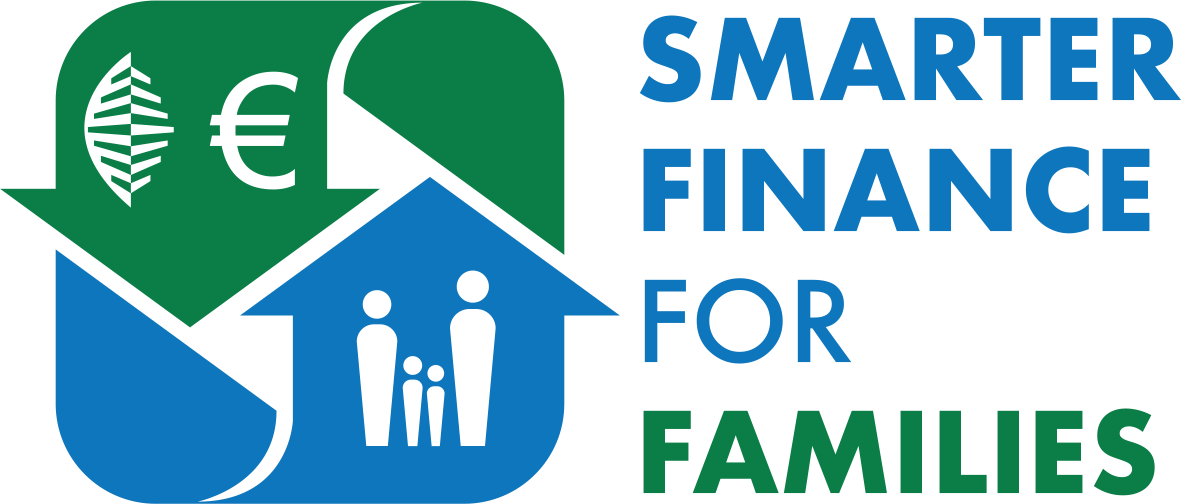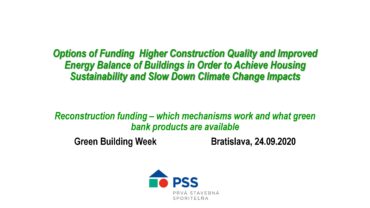In Bratislava, on 24.09.2020 – Green housing as a responsible and sustainable alternative is trending in Slovakia and the world. As part of the currently held 10th annual Green Building Week, the Slovak Green Building Council (SKGBC) provided space for a meeting of experts and stakeholders discussing on green housing and green funding.
The green and sustainable building market has undergone significant changes over the last years. “From the first attempts with the ‘green’ being more a marketing tool than a real result, we have moved towards measurable and demonstrable parameters. High-quality green building is a complex system which requires cooperation of the individual systems from the early beginning of its planning,” said Tomáš Guniš, architect specialist with Saint-Gobain Construction Products, s.r.o., who has been dealing with the topic of sustainable architecture and city adaptations to climate changes. “The COVID pandemic has been locking us inside our homes. We have realised how fragile our health is and this has led to increased interest in healthy and ecological housing. High-quality green building is a complex system which requires cooperation of the individual systems from the early beginning of its planning. That is why we have come up with the Multi Comfort concept. With its holistic approach, it sees the building as a whole and tries to provide maximum comfort to the users on various levels – heat, light, acoustics, and air quality.”
Green Funding
“Green or sustainable housing is housing which has been planned and built with the goal to minimize the current and future environmental impact during its existence,” said Hana Ovesná, Executive Director of the Slovak Green Building Council. In order to achieve best economic, social and ecological green housing parameters, the best time to invest into energy efficiency is at the very beginning – when establishing new designs. Therefore, it is necessary to get the finance world, residential investors, developers and solutions providers on board to support the development of energy efficient and sustainable housing.
“Over the last years, terms like ‘green funding’ or ‘green mortgage’ have emerged which have made some stir in the business world and with the public who are looking for new housing or reconstructing their old homes,” said Hana Ovesná, introducing the important issue of investing into sustainable housing. According to her, this concept represents a huge opportunity to improve the environmental performance, quality, health, comfort, and financial viability of new and current apartments in Europe. SKGBC and 16 other specialised associations focusing on sustainable buildings and green energy in Europe came together to start the SMARTER Finance for Families initiative. “It is time to provide responsible loans and build reasonable buildings,” said Steven Borncamp, Project Director of the Romania Green Building Council. “We help the banks to define which residential projects are truly green. We provide studies confirming the loan interest rate reduction and data of previous residential projects as evidence of previous projections.”
Miloš Blanárok and Katarína Niňajová with the financial company of Prvá stavebná sporiteľňa presented their take on funding options at improving the construction quality and energy balance of buildings in order to achieve long-term sustainability. “At each of the planned building investments, we should focus on 3 key goals – healthy, safe and non-conflicting use of the building. It does not matter whether the building is residential, administrative, commercial or a production facility – or a combination thereof. The swiftest and simplest achievement of the goals should be the main motto of the product offer of banks – in particular, at residential buildings.” They also presented examples of solutions supporting and favouring the investments into environmentally sustainable property: “Our bank provides more than two thirds of loans for house and apartment house reconstruction. In current situation, with at least 300 thousand apartments and over 500 thousand houses still to be reconstructed and less than 20 thousand new apartments built each year, this is a significant role we play in reducing the climate change impacts. Renovation is important for prolonging the lifetime of residential property, as well as reducing the emissions by improving the energy balance of the apartment houses. If the owners or investors prepare a really complex reconstruction plan, it is more expensive – which our bank compensates by lower loan interest rates.” As a specific case study, we present the first apartment house reconstructed to meet the low-energy building standards, including the use of alternative energy sources (heat pumps and photovoltaics), and fauna preservation measures – nesting spaces for bats and swifts. The house is in P. Horova Street in Bratislava and we provided 50 % of the funding in a PSS, a.s. loan.
Houses Like Trees
There are several approaches of how to create green sustainable housing. However, all are environment friendly in terms of design, construction and operation. Energy efficiency and economy of the building, quality level at designing, constructing and its use are intertwined. It is also about general direct impacts on the surroundings of the green buildings (in particular, in cities).
“City agglomerations have been dealing with heat islands more and more in the recent years. Green buildings are among the most efficient solutions to achieve natural heat stabilisation using additional green areas on roofs and façades in cities,” said Milan Galandák, architect with LIKO-S. Each euro we invest in green buildings, comes back in energy savings, lower rainwater drainage costs, maintenance, higher appeal, and – last but not least – better health of the people.
Galandák said that an important catalyst of the changes are “…progressive architects and developers, as well as municipalities. It is important for them to set clear terms and provide global support to positive changes in order for this trend to become a defining element of buildings in our cities.”
Green Surroundings
However, housing is not limited to the space within our four walls. It is also about the surroundings. A solution may be grant-based co-funding of revitalisation of neglected land in residential areas for apartment owners, the managers, villages, and towns. Thanks to the support of PSS, a.s., in 2019 and 2020, the Bratislava borough of Karlova Ves built reservoirs for rain water, new green zones and covered playgrounds to shield them from excessive sunlight. In Veľký Šariš, we implemented a sample block of flats waste management project. Most of the projects focus on adding green areas and creating resting zones in towns and villages, with direct impact on quality of the environment, as well as quality of education quality of the young.
Green Building Week 2020
- 22nd September 2020 – Green Business Breakfast webinar (SMART Solutions in Buildings)
- 23rd September 2020 – Green Business Breakfast webinar (Reducing Carbon Footprint)
- 24th September 2020 – Green Business Breakfast webinar (Green Housing)
All webinars are free of charge and one can apply to participate via www.skgbc.org. The webinars are being supported by the general partner of the Green Building Week – company of Saint-Gobain Construction Products – and our main partners – companies of Baumit, LIKO-SK, Padus Allestimenti, and VELUX SLOVENSKO.
- 29th September 2020 – international expert conference of Sustainability in Architecture and Construction – in cooperation with the Eurostav publisher. You can apply for this event and buy tickets at skgbc.org.
Slovak Green Building Council (SKGBC) is the main ambassador of sustainable constructions in Slovakia. It focuses on the designs and new constructed buildings to have healthy interior environment and save energy and other resources.
Press Contact:
Petra Gibalová
Slovak Green Building Council
Mobile: +421 915 774 241
Email: events@skgbc.org
Share this
Sectors: Buildings, Finance
Country / Region: Slovakia
Tags: carbon footprint, efficient construction of buildings, emissions, environmental impacts, green zones, light emitting diodes, loans, projects, SMARTER, solar photovoltaic, stakeholdersIn 1 user collection: SMARTER – Events
Knowledge Object: User generated Initiative
Published by: Slovak Green Building Council (SKGBC)
Publishing year: 2020
Author: Petra Gibalová


